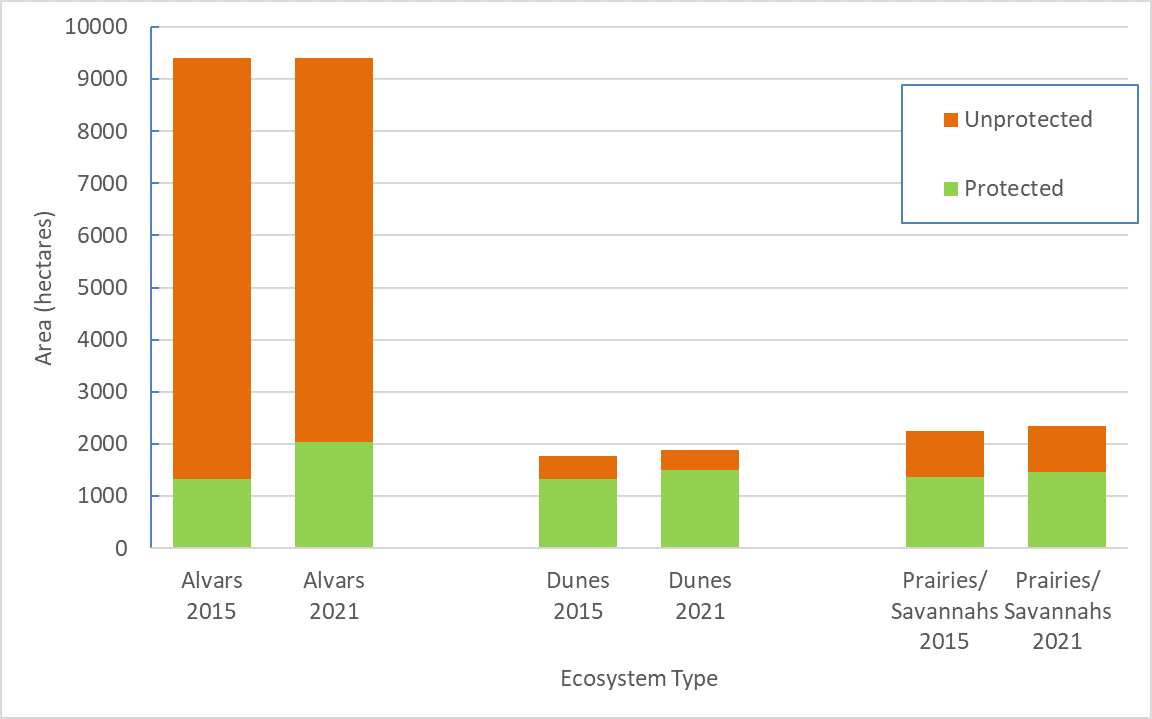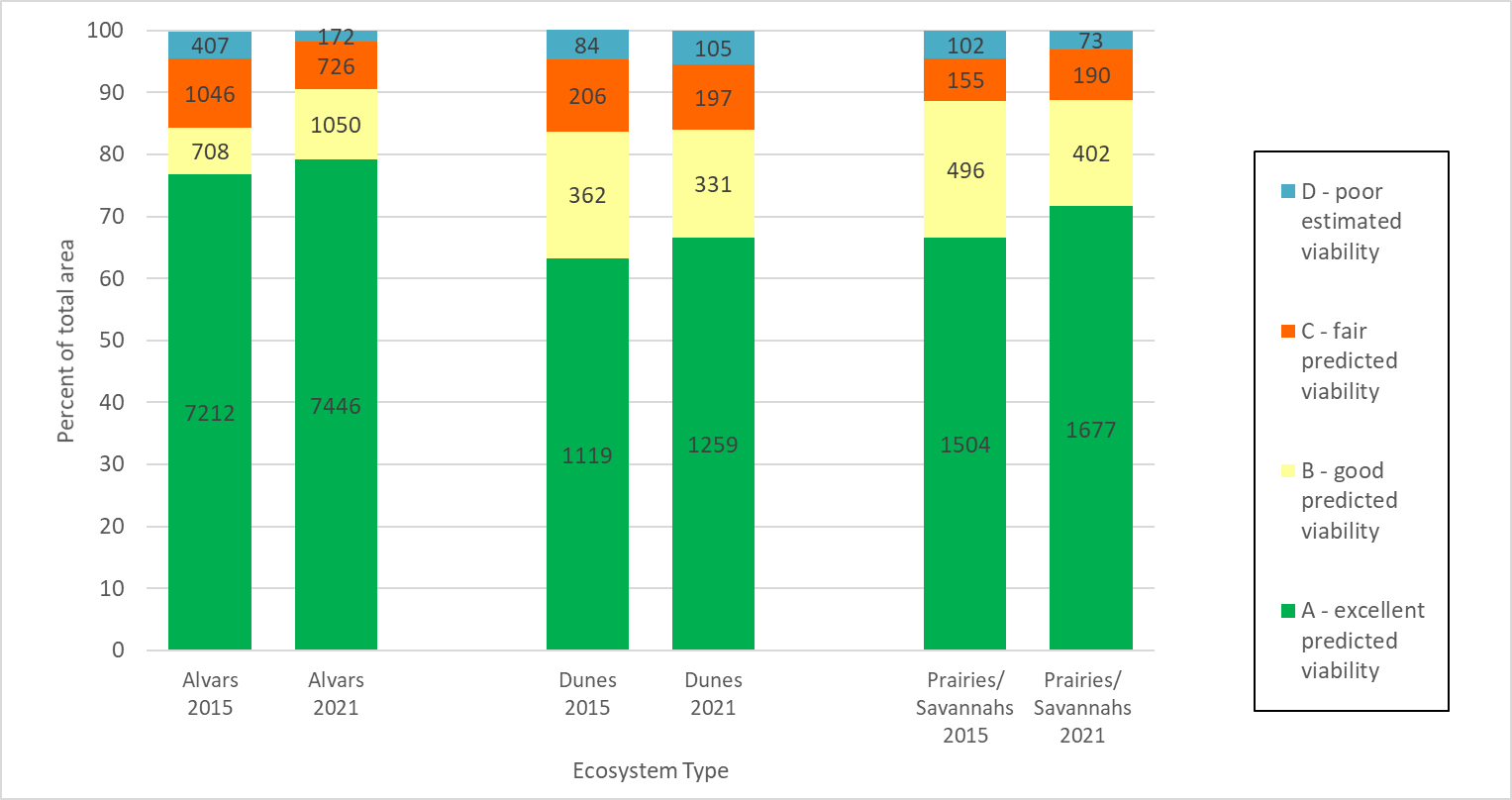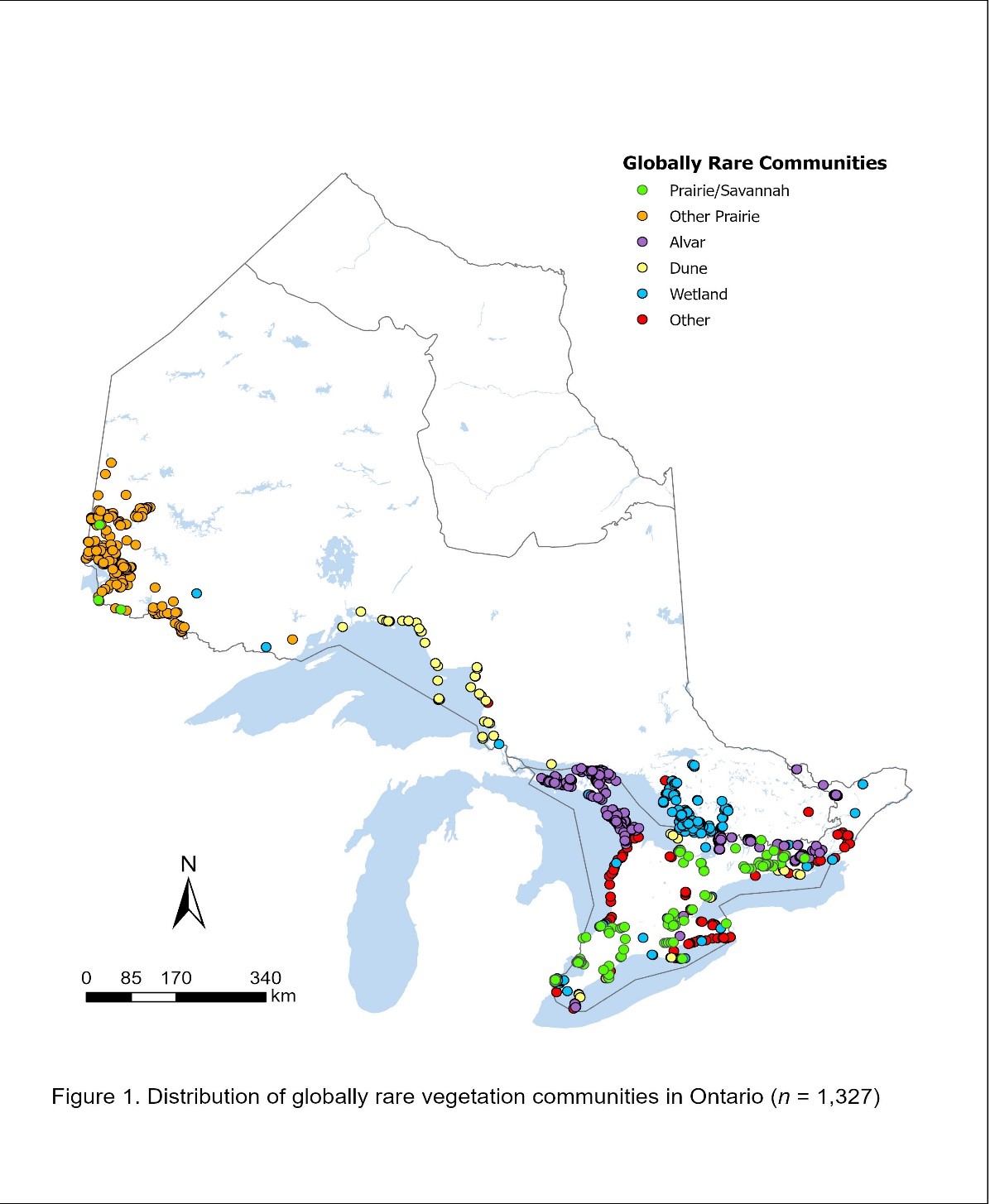
Figure 2. Total area of alvar, dune and prairie/savannah ecosystems in Ontario showing amount of each type that is legally protected in 2015 and 2021 (source: NHIC database, MNDMNRF, Peterborough, ON).
A
 * labels represent the number of occurrences
* labels represent the number of occurrences
B

*labels represent area in hectares
Figure 3. A) Proportion of vegetation community occurrences with quality ranks A–D in alvar, dune and prairie/savannah ecosystems in 2015 and 2021 (labels indicate number of occurrences); B) Proportion of area with quality ranks A-D in alvar, dune and prairie/savannah ecosystems in 2015 and 2021 (labels indicate area in hectares) (source: NHIC database, MNDMNRF, Peterborough, ON).
Status:
- Alvar ecosystems cover more area than the other rare ecosystem types, with 21% of their total area legally protected, this is an increase from the 14% of total area protected in 2015. It is estimated that conservation lands contribute to protecting an additional 10% of Ontario’s total alvar area.
- More than half, 62% of the remaining prairie/savannah ecosystems, are legally protected up slightly from 61% in 2015, while 79% of freshwater coastal dune systems are in protected areas, up from 75% in 2015.
- Over two thirds of the occurrences of rare vegetation communities in all three ecosystems types were assigned an excellent or good predicted viability ranking (69% in 2021 and 68% in 2015).
- In 2021, 89% of the total area were assigned an excellent or good predicted viability ranking , compared to 85% in 2015.
- The difference between the percent of high-quality rankings for number of occurrences vs. total area reflects the higher quality of larger areas and the consideration of size when assigning ranks.
Previous version: Indicator – Extent, Quality and Protection of Ontario’s Rare Ecosystems_May, 2015
Ontario’s diverse ecosystems include some that are of conservation concern due to their limited distribution and high proportion of specialized species absent from most of the province, such as prairies and savannahs (prairies with scattered trees), alvars (flat open limestone or dolostone habitats with thin soil), and freshwater coastal dunes. Although they are generally small in size, these habitats support many of Ontario’s endemic and other provincially rare flora and fauna. As such, they are fundamentally important for the conservation of biodiversity in the province.
The extent of prairie and savannah habitat in Ontario has been greatly reduced; in the Mixedwood Plains Ecozone, only a fraction (2–3%) remains (2,200ha; Rodger 1998) and this is threatened by habitat loss, invasive alien species, and succession to forest due to fire suppression. Globally rare alvar communities occur only in the Baltic region of Estonia and Sweden, in western Russia, the northern peninsula on the island of Newfoundland, the west side of Great Slave Lake in the Northwest Territories, the Interlake region of Manitoba, Saskatchewan Delta , and within the Great Lakes Basin of North America (Brunton and Catling, 2017). Ontario contains 65–70% of the North American total, including sites on the Bruce Peninsula, Manitoulin and Pelee islands, and on the Napanee, Smith’s Falls and the Carden limestone plains. Alvar ecosystems in Ontario face similar threats as prairie and savannah habitats, but also conversion to quarries. Great Lakes sand dunes make up the world’s largest collection of freshwater coastal dunes (SOLEC 2009). Ranging from the high forested dunes and linear dune ridges commonly backing sand beaches, to active, moving dune fields, sand dunes can be found along the coasts of all the Great Lakes. Freshwater coastal dunes are fragile ecosystems that are easily affected by human activities.
The distribution and status of these rare ecosystems is tracked by Ontario ’s Natural Heritage Information Centre based on plant communities (assemblages of plant species with a consistent composition, structure and habitat). To date, more than 1,300 occurrences of vegetation communities that are considered to be globally rare by NatureServe have been documented in Ontario (Figure 1). Sixty percent of these globally rare communities occur within the Mixedwood Plains Ecozone. There are other globally rare communities that have been documented from Ontario that lack comprehensive information and are not included in this indicator.
This indicator assesses the total area and quality of prairie, savannah, alvar, and dune ecosystems in Ontario, and the area of each that is legally protected in the province.

Analysis for this indicator was based on detailed spatial data available through the Natural Heritage Information Centre. The areas of rare vegetation communities were summed to assess the total area of prairie and savannah, alvar and dune ecosystems in Ontario (Figure 2). The boundaries of vegetation communities in these rare ecosystems was overlain with the boundaries of protected areas (Provincial and National Parks, National Wildlife Areas, and Conservation Reserves) using GIS to determine the proportion of each rare ecosystem type found in protected areas. Rare communities in protected areas are sometimes subjected to disturbance and threats from human use, but are generally not subject to development and the same level of threats as non-protected areas. The total area and proportion of protected area for alvar and freshwater coastal dune communities have been refined from data originally reported in the State of Ontario’s Biodiversity 2015 report based on new survey information and refined digitized polygons based on more recently available orthophotography. Prairie/savannah communities assessed in this indicator are limited to those on deep soils and the analysis does not currently include prairie communities on shallow soils that are found in northwestern Ontario (‘Other Prairie’ category in Figure 1).
In addition to the total area and level of protection, the status of vegetation communities was assessed using element occurrence ranks that are based on an assessment by the Natural Heritage Information Centre. Extant plant communities were assigned element occurrence quality ranks from A – D (Table 1) based on NatureServe data standards. Ranks were based on an examination of the size, condition, and landscape context of vegetation communities (Table 2). A full description of the ranking methodology can be found in Henson and Bakowsky (2014). For each rare ecosystem type, the total number and area of element occurrences assigned to each quality rank were tallied and plotted to compare changes between 2015 and 2021 (Figure 3).
It is important to note that the proportion of each rare ecosystem in protected areas is based on provincially and federally protected areas and does not include conservation lands held by private conservation organizations, municipalities, or Conservation Authorities. These conservation lands account for important additional protection for some rare ecosystems, but have not been assessed due to the lack of consolidated, comprehensive information on their spatial boundaries. For instance, the Nature Conservancy of Canada continues to actively expand Canada’s network of protected areas, an assessment of alvar ecosystems in 2015 by the Nature Conservancy of Canada showed that conservation lands contribute to the protection of an estimated additional 960 ha, almost equal to the amount in legally protected areas (D. Kraus, Nature Conservancy of Canada, personal communication).
Table 1. Element occurrence quality ranks assigned to vegetation communities in Ontario’s prairie, savannah, alvar and dune ecosystems.
Quality rank
|
Description |
| A |
Excellent predicted viability |
| B |
Good predicted viability |
| C |
Fair predicted viability |
| D |
Poor estimated viability |
Table 2. Description of factors considered when assessing quality of vegetation community element occurrences (see Henson and Bakowsky 2014).
| Status |
Definition |
| Size |
Area of occupancy |
| Condition |
Development/maturity (stability, old-growth) |
| Ecological processes (degree of disturbance by logging, grazing, changes in hydrology or natural fire regime) |
| Abiotic physical/chemical factors (stability of substrate, physical structure, water quality) |
| Landscape context |
Landscape structure and extent (pattern, connectivity e.g., measure of fragmentation/patchiness, measure of genetic connectivity) |
| Condition of the surrounding landscape (i.e., Development/maturity, species composition and biological structure, ecological processes, abiotic physical/chemical factors) |
Web Links:
Natural Heritage Information Centre https://www.ontario.ca/environment-and-energy/natural- heritage-information-centre
NatureServe Conservation Status Assessment https://www.natureserve.org/conservation-tools/conservation-status-assessment
Sask River Delta Conservation Initiative https://www.saskriverdelta.com/alvar
References:
Bakowsky, W.D., and B.L. Henson. 2014. Rare communities of Ontario: freshwater coastal dunes. Natural Heritage Information Centre, Ontario Ministry of Natural Resources, Queen’s Printer for Ontario, Peterborough, ON.
Brunton, D. F. and P.M. Catling. 2017. Thematic Collection: Alvars in Canada. Canadian Field Naturalist 131(1):75-79.
Henson, B.L., and W.D. Bakowsky. 2014. Plant community ranking methodology: alvars, dunes, prairies. Natural Heritage Information Centre, Ontario Ministry of Natural Resources and Forestry, Peterborough, ON. [Available at: https://sobr.ca/wp-content/uploads/Henson- and-Bakowsky-2014_Plant-Community-Ranking-Methodology-Alvars-Dunes-Prairies.pdf]
Ontario Biodiversity Council. 2015. State of Ontario’s Biodiversity [web application]. Ontario Biodiversity Council, Peterborough, Ontario. [Available at: www.sobr.ca]
Rodger, L. 1998. Tallgrass communities of southern Ontario: A recovery plan. Report prepared for World Wildlife Fund Canada and the Ontario Ministry of Natural Resources.
State of the Lakes Ecosystem Conference (SOLEC). 2009. State of the Great Lakes 2009. Technical report prepared by Environment Canada and the United States Environmental Protection Agency. [Available at: http://www.epa.gov/solec/]
 * labels represent the number of occurrences
* labels represent the number of occurrences


